How To Get Cats And Dogs To Get Along
Despite the classic idiom "fighting like cats and dogs" there are many dogs that are good with cats.
When you are looking for dogs that are good with cats, it's a bonus if you already have one of these cat breeds that get along with dogs. Still, even the most easy-going cats may not be a good fit for certain dog breeds, particularly those in the herding, sighthound, or terrier group. Of course, every dog is an individual, but herding dogs are hard-wired to "herd" anything that moves, including small children and cats. A cat's sudden movement might set off the prey drive in sighthounds and terriers, making it hard to resist the impulse to chase.
ⓘ
That still leaves plenty of dog breeds that get along with cats. In fact, some of the most popular dog breeds are calm dog breeds and low-maintenance dog breeds, which could be a purr-fect combination for a feline roommate. And if you need assurance cats and dogs can live in the same house, look at these photos that prove cats and dogs can be best friends.
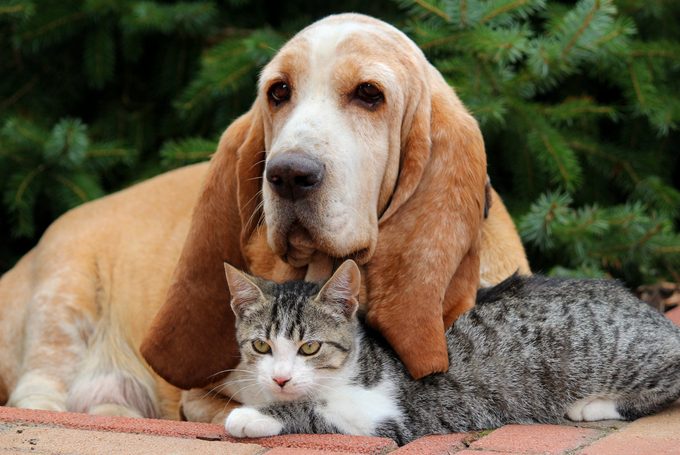 bodza2/Getty Images
bodza2/Getty Images
1. Basset hound
Aside from their penchant for howling—ahem, melodious merrymaking—the Basset hound, with its long, floppy ears, is about as mellow as you can get. They are also incredibly loyal and patient, which will go a long way during the introduction and acclimation period with their feline sibling. With those attributes, the Bassett hound is one of the best dogs breeds for cats.
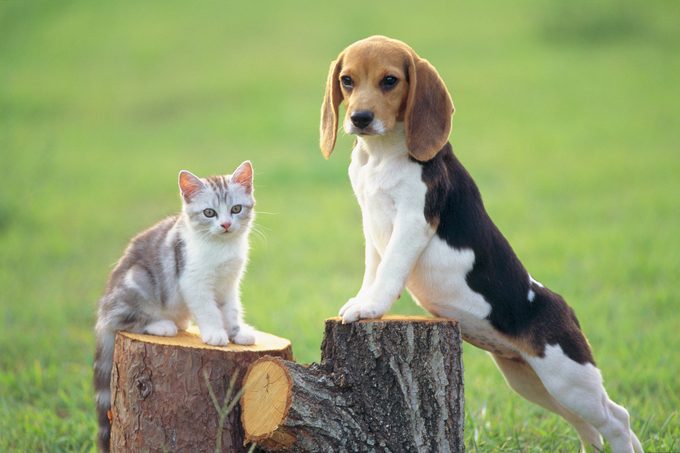 DAJ/Getty Images
DAJ/Getty Images
2. Beagle
Beagles were bred to hunt in packs, so they're already open to sharing their space with other animals and people. Unlike Snoopy, who merely puts up with Woodstock, beagles in real life thrive on interaction with other dogs, pets, and people, making them a top candidate for dogs that get along with cats. Though your cat might wonder why dogs howl when the beagle gets so excited about the same ole squirrel that's been in the yard forever, other than the occasional annoyance, there probably won't be any fur flying.
 robin cook photography/Getty Images
robin cook photography/Getty Images
3. Bulldog
Built low to the ground with a body like a tank, the Bulldog appears as a four-legged bully. Well, maybe to other dogs. They generally don't make fast friends with other dogs, but cats and other pets are more welcome. Its short snout makes it prone to heatstroke and its short coat doesn't fair well in the cold. Plus, they aren't fans of the water and they are lazy dogs that make excellent nappers, so the Bulldog and your cat already have four things in common, making them one of the best dogs that get along with cats.
 Mark Liddell/Getty Images
Mark Liddell/Getty Images
4. Cavalier King Charles spaniel
"Cavs" are likely one of the most beloved toy dog breeds that stay puppy-sized forever. They have huge hearts of gold and bestow love on everyone they meet, which is why they make great emotional support dogs. The exact intuitive nature that provides affection and encouragement for patients in hospitals and nursing homes is ideal for sharing a home with a cat. Cavs know how to back off when they should and they're open to a feline napping buddy. And because Cavs prefer to always be in the company of people or pets, they'll love having a feline roomie while you're out.
 Fuse/Getty Images
Fuse/Getty Images
5. Collie
We know what you're thinking—how did a member of the herding group make it on the list for dogs that get along with cats? Collies are one of those exceptions. (Think about Lassie. Would she drive a harmless cat into a corner?) Collies are remarkably loyal to their human and furry siblings. Because they are wicked smart and sweet, they can learn how to interact and adjust to living with a cat sibling.
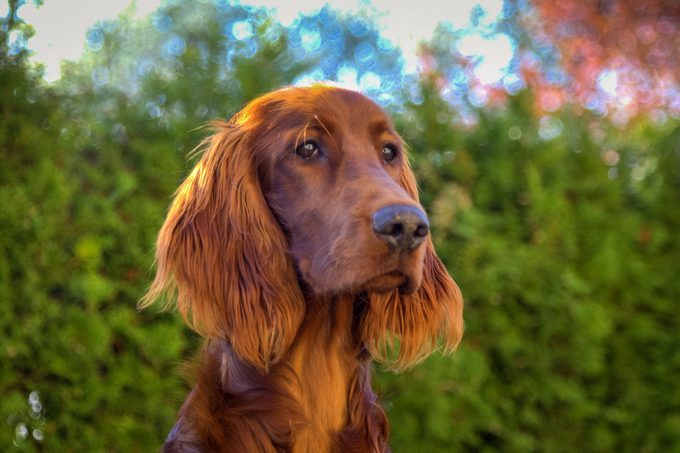 Achim Schuelke/Getty Images
Achim Schuelke/Getty Images
6. Irish setter
If an Irish Setter can cross party lines and make friends at the White House, surely this gorgeous red, feathery coated dog can peacefully co-exist with a cat. This high-energy and boisterous dog is literally a party animal and happy to mingle with new friends, including cats. It would be difficult for even the grumpiest cat to ignore an invitation to play with their fun-loving Irish setter.
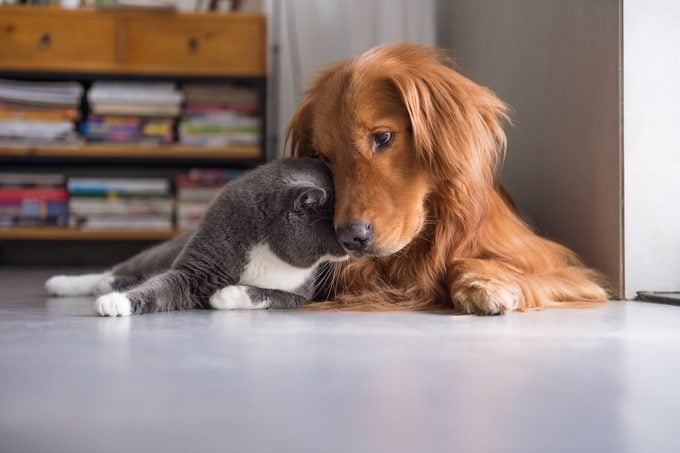 chendongshan/Getty Images
chendongshan/Getty Images
7. Golden retriever
Even people who aren't familiar with dog breeds know the Golden Retriever has to be one of the best dog breeds for cats because they are so sweet, friendly, and hopelessly devoted to their family—including cats. They seem to have a limitless supply of empathy and compassion, on top of which, they're eager to please, goofy, playful, and highly adaptable.
 eAlisa/Getty Images
eAlisa/Getty Images
8. Poodle
Pick any size poodle (they come in miniature, toy, and standard), and your cat will thank you for getting a dog that gets along with cats. Poodles are good-natured, eager to please, and valedictorians of the dog world. Besides being able to master the new dog tricks you teach them, they will learn fast and sense when your cat is cranky and back off or be open for sibling snuggles. Plus, they're one of the dog breeds that don't shed that much.
 Kimberlee Reimer/Getty Images
Kimberlee Reimer/Getty Images
9. Labrador retriever
There are some pet combinations that are most likely to hate each other, but a Labrador retriever would never be the type to show his teeth in dislike. There's a reason why Labs are guide dogs, search and rescue, and emotional support dogs. They're kind, gentle, accomodating, and always find the good in everyone, even if that new someone is a cat they haven't had the pleasure of meeting.
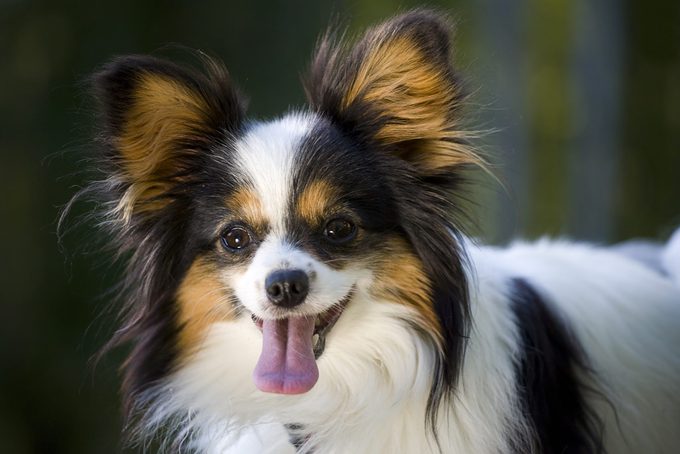 RichLegg/Getty Images
RichLegg/Getty Images
10. Papillon
Even if the butterfly-ears tempted your cat to play, the Papillon probably wouldn't mind. They would probably see it as a friendly game. Papillons are up for anything, with anyone, all the time. Need two more reasons why a Papillon is a good option for the best dog breeds for cats? As a small dog lap lover, they can snuggle side by side on you with their kitty sibling. And they can both potty indoors, as the Papillon can learn to use an indoor potty system.
 Bigandt_Photography/Getty Images
Bigandt_Photography/Getty Images
11. Tibetan spaniel
Unlike some toy breed dogs who like to whoof-it-up when they hear a pin drop, you probably won't have too many barking issues with a Tibetan spaniel. Thank goodness, because non-stop barking could unravel your cat's nerves. Tibbies are little fluffy lovers who are happy-go-lucky and fiercely devoted to their human. Yet they do have a little independence streak that is adorably frustrating at times. Like some cats, they favor higher places to observe and hold court. In time, your cat and Tibbie may rule you, but you won't care because they're the cutest monarchs you've ever seen.
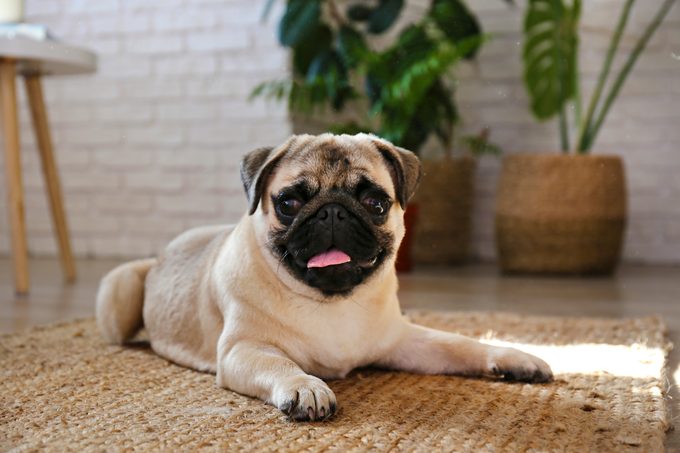 Getty Images
Getty Images
12. Pug
You might want to get a pet camera to keep tabs on the shenanigans your cat and pug could get up to. Pugs were voted "class clown" at doggy obedience class. You can bet they are going to be stoked to have a sidekick to join their fun and games. Your cat won't have dull days waiting near the window and then playing hard to get when you get home anymore. Don't worry about being the odd one out—a pug will save enough energy for you, and be ecstatic to see you when you get home.
 SolStock/Getty Images
SolStock/Getty Images
13. Cocker spaniel
These sweet people-pleasers enjoy the company of other animals, making them one of the best dog breeds for cats. Cocker spaniels are playful and congenial dogs who love attention, and they don't discriminate when it comes to who gives them that attention. They love a good head scratch from you, and their passive natures mean they'll likely be okay with licks from a fastidious cat sibling, too. After all, someone has to keep those long and curly ears clean. Plus, they make a cozy weighted blanket for your little lion.
 SergeyTikhomirov/Getty Images
SergeyTikhomirov/Getty Images
14. Bichon Frise
The Bichon Frise is one of the best dog breeds for cats. These happy-go-lucky little balls of white fluff love everybody, cats included. Frolicsome by nature, Bichons are likely to see your cat as a potential playmate. Because of their lively and bubbly personality, they may be more interested in more spirited playtime, so they might not do well with a cat that has anxiety issues.
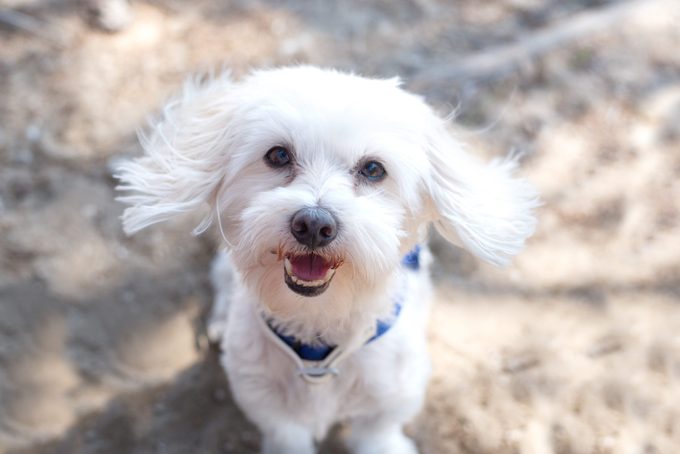 Ioannis Tsotras/Getty Images
Ioannis Tsotras/Getty Images
15. Maltese
The disposition dial on the Maltese is perpetually fixed on "charming and cheerful." Yet these little nuggets are lively and play hard, but because of their size, they could easily get toppled at the dog park. Since they make friends quickly with furry friends, playing with someone closer to their size (your cat) could be a good alternative. And although they appear to have loads of warm and cozy fur, they don't have a thick undercoat, so they're not keen on cold weather, so you're cat will have company and a built-in snuggle buddy on chilly days.
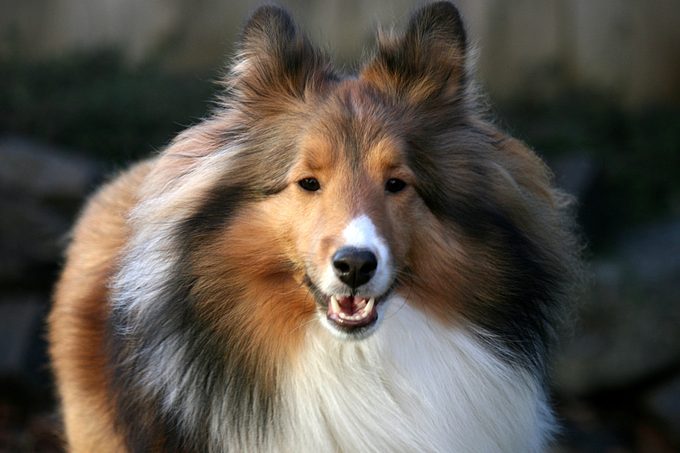 mccun934/Getty Images
mccun934/Getty Images
16. Shetland sheepdog
Another member of the herding family, shelties think the world of their family, including little humans and animals alike. Because of that, they likely won't be hung up on herding your cat as long as they get their exercise in and put their sharp intellect to use, uncovering treats with fun and challenging dog puzzles. Shelties have a proclivity to bark when they get bored, which may be unnerving to your cat. On the other hand, a Sheltie might not get too bored around your cat, especially if it has a daily zoomie ritual that could be mildly entertaining to watch.
 Purple Collar Pet Photography/Getty Images
Purple Collar Pet Photography/Getty Images
17. German shepherds
The German Shepherd, a revered guard dog, is known for its loyalty, which also extends to the entire family—humans and animals. Because they feel it's their job is to look after their family first, they don't make fast friends with other dogs they might run into on a walk. Yet when their human introduces them with proper socialization, a German Shepherd merely assumes the cat is part of the package deal and can live harmoniously with their tabby sibling.
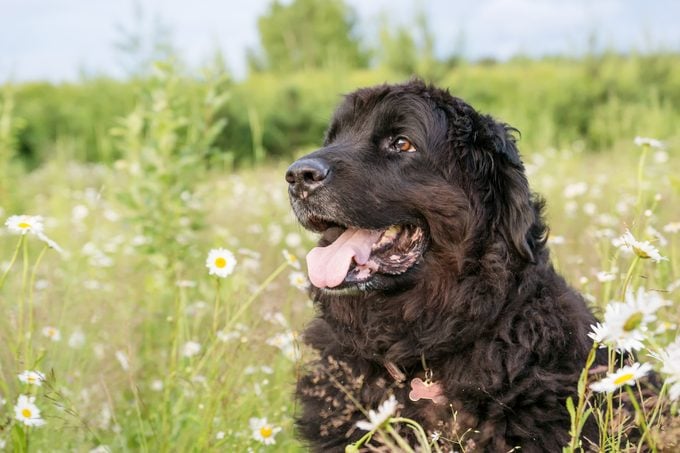 tayfoon/Getty Images
tayfoon/Getty Images
18. Newfoundland
Despite being one of the biggest dog breeds, Newfies are gentle giants. And Newfies are as sweet as the day is long. They're remarkably gentle and instinctually aware of their size, around tiny humans and animals. They're renowned for their guardian-like watchful presence while still being a kind, playful and interactive "nanny" with their "charges." That includes small children and pets, including cats. A Newfie will likely adopt your cat and consider it a friend in due time.
 choja/Getty Images
choja/Getty Images
19. Bernese mountain dog
Here's a big hunk of burning love to add to the collection of best dog breeds for cats. Berners, a mountain dog breed, are sweet-tempered, with unsurpassed affection for their family. Like other working breeds, they thrive in families who enjoy outdoor activities. Berners assume they are a legit member of your family and want to be involved in whatever you're doing, especially if it's playing or working outside. That's a plus for a cat who covets "me" time indoors.
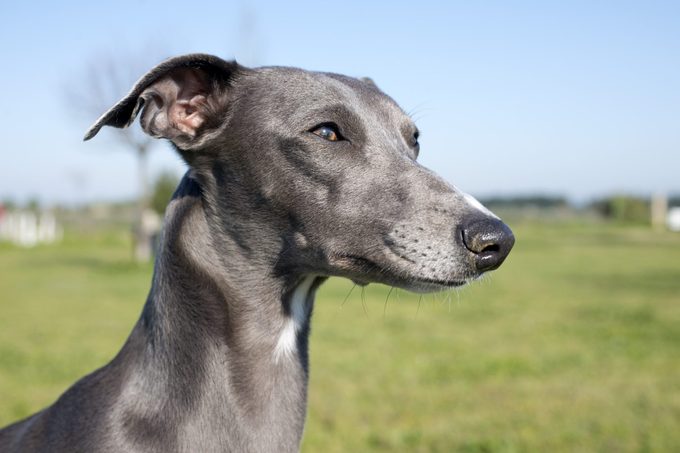 cynoclub/Getty Images
cynoclub/Getty Images
20. Greyhound
As one of the best apartment dogs for small spaces, the greyhound is a quiet, gentle, and chill dog breed, ideal for cats who savor peace and quiet. Though they are built for speed, Greyhounds fizzle fast. Even though it's a sighthound, once it's had its exercise for the day, greyhounds are content to lay around the house, like most cats. And greyhounds are fond of curling up and soaking in the sun near a window. They also relish a quiet and calm household and rarely get agitated.
 Manuel Breva Colmeiro/Getty Images
Manuel Breva Colmeiro/Getty Images
21. Barbet
What cat wouldn't want to make biscuits on this shaggy, curly-haired dog? And you know, the Barbet probably wouldn't mind—or even feel cat paws with all that dense fur. Besides the five-star snuggle appeal, the Barbet is a sweet-natured breed that is very easy to live with, as long as their exercise needs are met. Your cat can stretch out and relax while you and the dog log in a few daily walks and playtime in the backyard. When it's time to turn in, don't be surprised if your cat nonchalantly scootches its way in next to that cozy fur for a little snooze.
How to introduce a new dog to your cat
As much as you want your two beloved pets to be besties, it's not likely to happen overnight. "Go slow to go fast!" advises Collen Demling-Riley, a canine behaviorist at Dogtopia. "If the dog and cat have initial negative interactions, then it will be much harder for them to become friends."
Cats are territorial and can experience fear and anxiety if they feel their space is at risk. Before you make the introductions, gauge your cat's mood. Luckily, cats convey plenty of non-verbal communication with their body. A cat's tail gives us plenty of clues to their mood.
 Janie Airey/Getty Images
Janie Airey/Getty Images
Step one: Separate but within smelling distance
"The dog and cat should always be separated by a barrier for at least the first two weeks," advises Demling-Riley. Crate the dog and/or use a sturdy gate to block the dog from making contact with the cat while it is roaming around the house. When it's the dog's turn to explore the house, be sure the cat is in a room with the door closed. While you're in the phase, focus on scent communication. Place a sock or blanket with your dog's scent in your cat's space and an item with the cat's scent in the dog's space. If they're not showing signs of stress, fear or aggression, move to the next phase.
Step two: Give your cat space
"It's important to build up a slow and steady desensitization by gradually increasing the amount of contact to reduce the reaction of both cat and dog," says Danielle Bernal, a global veterinarian with Wellness Natural Pet Food. As you slowly open doors and gates, ensure your cat has elevated and secure vantage points, like the top of the fridge, couch, or bookshelf, to survey their home. "Vertical space can let your cat establish status and control without having to engage in aggressive behaviors," adds Rachel Geller, Ed.D., certified cat behaviorist with Wellness Natural Pet Food. Your cat will also appreciate being able to travel incognito at ground level via hideaways behind furniture, cardboard boxes, and cat tunnels. Be sure you are giving both pets loads of affection and attention.
Step three: casual interactions
If there aren't any growling or hissing fits while they've been in separate areas, try introducing your pets in the same room. Look for signs the intro is going well. "Happy cats and dogs have relaxed body postures and will show causal curiosity toward each other when in the same room. There will be no vocalization and the pets will be easy to distract if needed," says Demling-Riley. Never allow pets to be together if the cat starts hissing, pin its ears or swish its tail back and forth or if the dog stiffens up, growls, or gives the cat a death stare. If it's not going so well, give them a one-minute break and try again. Then when you try again, be sure the cat has an elevated surface and the dog is on a leash. Praise both pets when they have calm reactions. "When the pup and cat become more acquainted, they should spend time together in the rest of the house and with fewer barriers," says Demling-Riley.
Step four: treats!
If things are moving along nicely, you can start creating positive associations with food. Cats and dogs can get to know each other a little better by eating in the same room. Keep them far enough apart in their comfort zones, place a highly desired treat in their bowl. As the cat and dog get more comfortable with each other, move the bowls closer. "Having the cat and dog eat in front of each other teaches them that positive things happen when the other is around," says Geller.
 chendongshan/Getty Images
chendongshan/Getty Images
Success!
As long as there aren't signs of fear, stress, or anxiety in your cat or dog, decrease the distance between the cat and dog each day, Dr. Bernal says. Reward the pets with affection and treats when they are in the same room. "Eventually, your cat will learn that the appearance of the dog means food, treats, playtime, and attention," says Dr. Bernal. If it all goes well, the cat will stop self-isolating and return to its everyday habits. Still, you should air on the side of caution and separate the dog from the cat when you are out of the house for at least the first 30 days, advises Demling-Riley. In time they could be the best of friends—or at least tolerate each other when left home alone.
Sources:
- Collen Demling-Riley, certified dog trainer and canine behaviorist, Dogtopia
- Danielle Bernal, DVM., global veterinarian, Wellness Natural Pet Food
- Rachel Geller, Ed.D., certified cat behaviorist, Wellness Natural Pet Food
How To Get Cats And Dogs To Get Along
Source: https://www.rd.com/article/dogs-that-are-good-with-cats/
Posted by: covarrubiaswheyed.blogspot.com

0 Response to "How To Get Cats And Dogs To Get Along"
Post a Comment